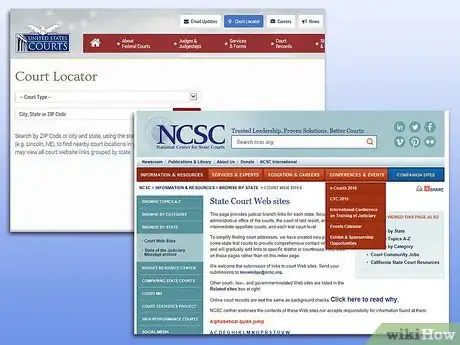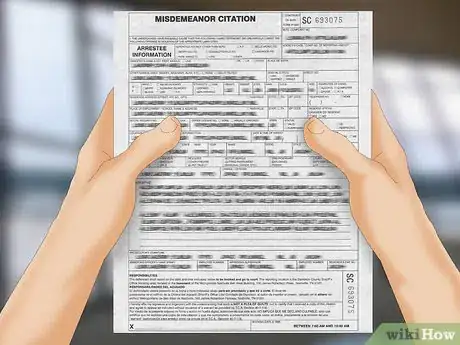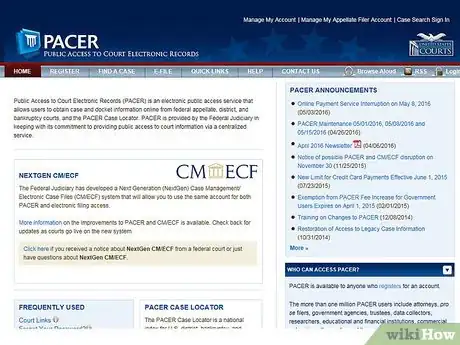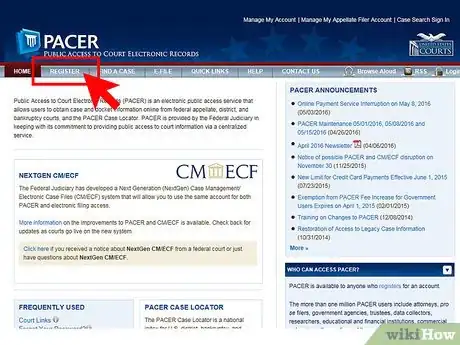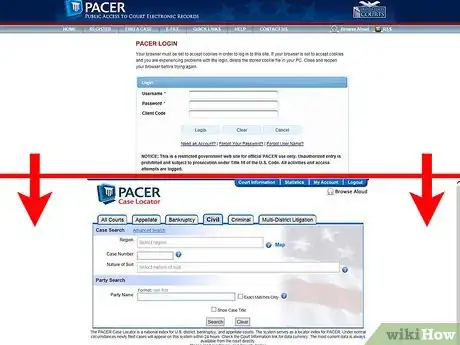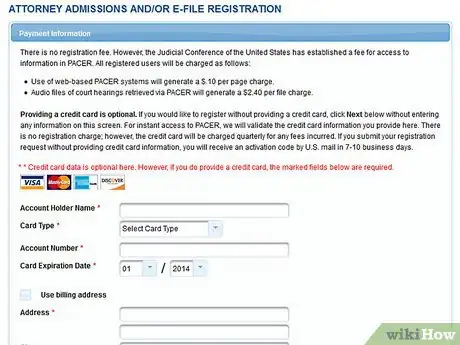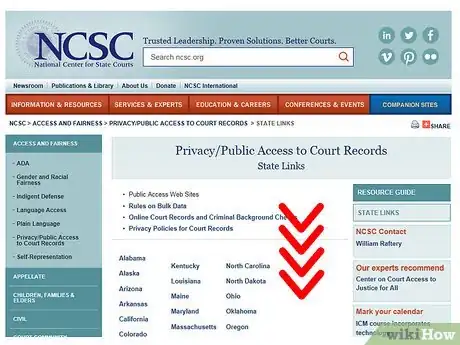This article was co-authored by Clinton M. Sandvick, JD, PhD. Clinton M. Sandvick worked as a civil litigator in California for over 7 years. He received his JD from the University of Wisconsin-Madison in 1998 and his PhD in American History from the University of Oregon in 2013.
There are 8 references cited in this article, which can be found at the bottom of the page.
This article has been viewed 146,575 times.
Many courts provide access to their records electronically, allowing you to access certain records via the internet from the comfort of your own home or office. However, electronic access to court records is inconsistent throughout the United States and some courts do not provide online access to records, and some maintain only basic information about a particular court case such as the case name, case number, and type of court. Nonetheless, if you need electronic access to court records, follow the steps below to learn about your options.
Steps
Determining If You Need Federal or State Records
-
1Understand the United States court system. In order to understand what type of records you will need to look for, you must first understand how the judicial system is set up in the United States. There is a hierarchy of courts at the state and federal level, with overlaps in certain places.
- At the federal level, at the top of the hierarchy is the United States Supreme Court, which is then followed by appellate courts and trial courts.[1] Both appellate courts and trial courts are divided into geographic based jurisdictions.[2] At the appellate level, these jurisdictions are known as “circuits” while federal trial courts are known as “districts. ”[3] There are also several federal courts with jurisdiction over a specific subject matter (e.g., bankruptcy courts and courts of international trade).[4]
- Similar to the organization of federal courts, at the top of the state court hierarchy is the state supreme court, which is then followed by the appellate courts and trial courts. Depending on your state, trial courts may be called "circuit courts," "superior courts," or even something else. State appellate courts will often be called "courts of appeal." Be aware of how your state designates its different courts.
- At some points in the judicial process, there is a possibility for overlap between the state and federal systems. For example, a case may be heard in front of both a state supreme court and the federal Supreme Court under certain circumstances. Be aware of this when you begin searching for court records.
- Look at these websites to learn about the names of all the federal and state courts.
-
2Assess the documentation you have. When deciding whether you need to search for state or federal court records, start by analyzing the documents you have in your possession. Different documents will have different information on them, so look for documents with the most identifying information about your case or situation. Typically, documents include information indicating the type of court (i.e., criminal or civil), the location of the court (i.e., federal, state, county, or municipal), and the specific designation of the court (i.e., California District Court of Appeals).
- For example, a criminal citation (a written form given to someone by a law enforcement officer in response to an alleged illegal act) will usually have information about the types of charges being brought against a person and will provide you with a court name and location where the person is required to report.[5] By looking at this, you can get an idea of what type of law is involved and what court is going to be hearing the case. This should allow you to decide whether you are in state or federal court.
- On the other hand, a document like a complaint (a court filing that states the issues in controversy in a given case) is going to have a cover sheet that includes the title of the exact court in which the complaint was filed. For instance, a complaint's cover sheet may be titled "In the United States District Court for the District of Massachusetts." This gives you all the information you need in order to determine that you are in federal court.
Advertisement -
3Determine the subject matter of your issue. Think about what you are looking for and decide what type of law it involves. This can be helpful because certain legal subjects are either predominantly state law or federal law, depending on the subject. For instance, contract law and family law are generally governed by state laws and not federal laws. If your research topic deals with one of these subjects, you will likely want to look in a state database. On the other hand, bankruptcy law, maritime law, and constitutional law are generally governed by federal laws and not state laws. If your research topic deals with one of these subjects, you will likely want to search in a federal database.
- Be aware that these are general rules and they do have their qualifications. There are situations in which federal courts can hear state law issues and state law courts can hear federal law issues.
-
4Make your decision. Once you have analyzed the documents you have in your possession, and have determined what the subject matter of your issue is, you should be able to determine if you need to search a federal database or a state database. If you determine that you need to access federal court records electronically, you will use Part 2 of 3 below. If you determine that you need to access state court records electronically, you will use Part 3 of 3 below. If you can not determine what type of court records you will need to access, try looking at both types of databases.
Accessing Federal Court Records
-
1Visit the Public Access to Court Electronic Records website (PACER). PACER is the federal government website that provides access to court records from the federal district courts, courts of appeals, and bankruptcy courts.[6]
- If you want to access United States Supreme Court records, which includes published opinions and oral argument audio files, visit the United States Supreme Court website. There you will be able to easily access all the information you need by clicking on the tabs at the top of the webpage. You will not need to log in or pay any fee to access this information.
-
2Establish a PACER account. Once you arrive at the PACER website, you must register and create an account.[7] In order to do so, click on the "Register" button found at the top of the homepage.[8] Follow the directions on the screen and complete your registration.[9]
- You will have the ability to create an account that fits your needs and PACER has registration options for attorneys and non-attorneys alike. Following the directions will allow you to customize your account settings as necessary.
- While there is no registration fee, there is a fee for every file viewed, downloaded, or printed.[10] If you would like instant access to court documents, you will have to provide your credit card information during registration.[11] However, if you do not provide your credit card information during registration, an activation code will be mailed to you within 7-10 business days.[12]
-
3Search for documents. Once you have registered and received your login information, you will have access to the PACER site. You can log in to PACER by going to the main page and clicking the "log in" button at the top right of your screen. Once you have logged in, you can search for a document.[13]
- If you know the location of your case, go to the court links page.[14] From there you can select the case that you want.[15]
- If you do not know where your case is located, you can search for it using the case locator.[16] When you access the case locator, follow the on-screen prompts to search for a variety of cases and documents.[17] You will be able to search for cases by their case number, case title, date it was filed or date it was closed, party names, or even by the region in which your case was filed in.[18] If you ever need help understanding the search criteria, you can always access the PACER User Manual here.
-
4Pay the required fee. Once you have searched for and found the court record(s) you need, you will have to pay the required fee.[19] PACER will charge you $0.10 per page whether you view, download, or print the document.[20] The charges for any single document is capped at $3.00 or 30 pages.[21] Be careful when you are searching on the PACER site because charges can build up quickly. Only search and access the court records you absolutely need.
- Fees will be waived if you spend less than $15.00 in a quarter.[22]
Accessing State Court Records
-
1Visit your state's courts website. Depending on what state your records are from, the process you will follow and the records you will have access to will vary drastically. Start your search by visiting your state's courts website. While there, look through the website for any links to court records and/or court records searches.
-
2Search the National Center for State Courts website. If you cannot find out how to access your state's court records electronically using the other methods discussed above, access the National Center for State Courts] website. Here you will be able to scroll through a number of state links and find out how to access state court electronic court records.
- First, scroll down on the webpage and find your state. Second, read through the information provided and click on any applicable link to start searching for court records.
References
- ↑ http://www.justice.gov/usao/justice-101/federal-courts
- ↑ http://www.justice.gov/usao/justice-101/federal-courts
- ↑ http://www.justice.gov/usao/justice-101/federal-courts
- ↑ http://www2.maxwell.syr.edu/plegal/scales/court.html
- ↑ http://www.ncsl.org/research/civil-and-criminal-justice/citation-in-lieu-of-arrest.aspx
- ↑ https://www.pacer.gov/
- ↑ https://www.pacer.gov/documents/pacermanual.pdf
- ↑ https://www.pacer.gov/documents/pacermanual.pdf
- ↑ https://pacer.psc.uscourts.gov/pscof/regWizard.jsf
- ↑ https://www.pacer.gov/documents/pacermanual.pdf
- ↑ https://www.pacer.gov/documents/pacermanual.pdf
- ↑ https://www.pacer.gov/documents/pacermanual.pdf
- ↑ https://www.pacer.gov/documents/pacermanual.pdf
- ↑ https://www.pacer.gov/documents/pacermanual.pdf
- ↑ https://www.pacer.gov/documents/pacermanual.pdf
- ↑ https://www.pacer.gov/documents/pacermanual.pdf
- ↑ https://www.pacer.gov/documents/pacermanual.pdf
- ↑ https://www.pacer.gov/documents/pacermanual.pdf
- ↑ https://www.pacer.gov/documents/pacermanual.pdf
- ↑ https://www.pacer.gov/documents/pacermanual.pdf
- ↑ https://www.pacer.gov/documents/pacermanual.pdf
- ↑ https://www.pacer.gov/documents/pacermanual.pdf
- ↑ https://www.courts.wa.gov/
- ↑ http://www.rcfp.org/rcfp/orders/docs/EACR.pdf
About This Article
Nowadays, you can access a lot of federal and state court records right from your computer. To access federal court records, use the PACER website. You’ll need to register for an account first, but then you’ll be free to search records by their case number, title, date, party names, or region. PACER charges 10 cents per page and a maximum of 3 dollars per document you view, but you can download and print them for no extra cost. To access state court records, visit your state court’s website. If your state court doesn’t have its own website, search the National Center for State Courts website instead. For more tips from our Legal co-author, including how to access supreme court records, read on!
